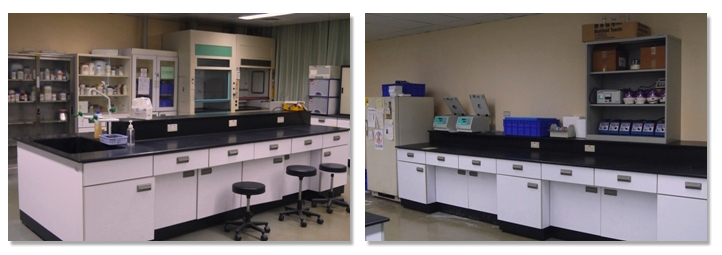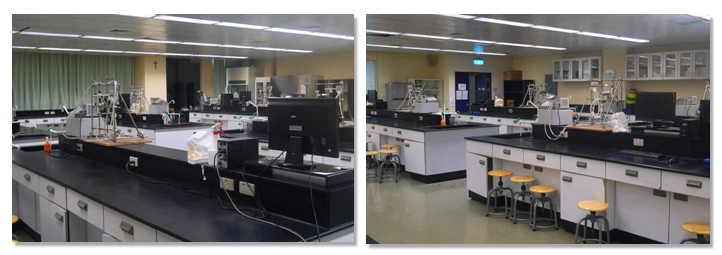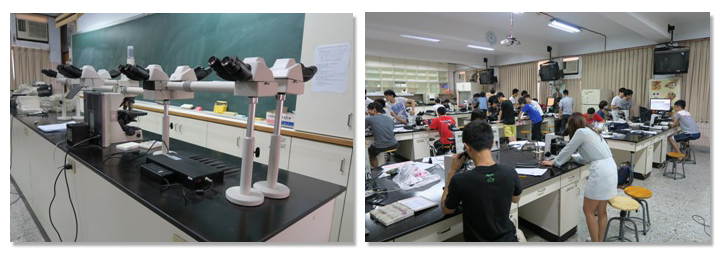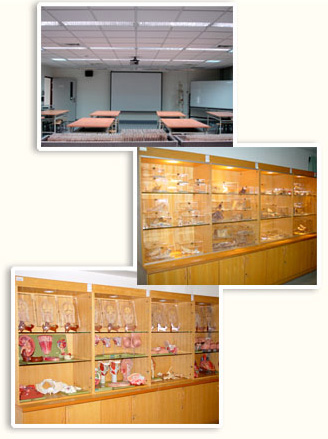|
|
|
|
As a teach-supporting laboratory, the Biochemistry Laboratory is equipped with a variety of instruments, including water baths, bench-top centrifuges, high-speed centrifuges, PCR machine, ELISA reader, micropipettes, DNA electrophoresis devices, and protein electrophoresis devices. At the same time, the Biochemistry Laboratory is also fully supported by high-end instruments in the College of Medicine, including high-resolution Orbitrap mass spectrometer, flow cytometer/sorter, and transmission electron microscopy.
Students can learn different qualitative/quantitative approaches to analyze the biomolecules, i.e. carbohydrates, lipids, and proteins. In addition, students can learn basic protein chromatographic methods, kinetic measurement of enzymatic activity, protein SDS-PAGE and western blotting, Besides the protein-related biochemical methods, student are also encouraged to learn basic methods in molecular biology, including cell cycle analyzed, plasmid DNA preparation, restriction enzyme digestion/ligation, and PCR experiments. Finally, students can also learn basic analytical methods in cell biology, such as flow cytometry, and confocal immunofluorescence microscopy. |
|
 |
|
|
|
|
|
The physiological and pharmacological laboratory is equipped with a variety of instruments, including blood glucose meters, multifunctional physiological monitors, rotator chairs, flame photometers, bench-top centrifuges, high-speed centrifuges, micropipettes, coagulation analyzers etc. These instruments assist students in learning phenomena of physiology in human and animals, as well as the pharmacological mechanisms of various drugs in vivo. |
|
 |
|
|
|
|
|
This laboratory is equipped with a variety of instruments and tools, including microscope, microscopic image projection and retrieval system, electronic eyepiece, paraffin tissue processing kit, histopathological slicing apparatus and pathological specimens, to facilitate students to learn the microscopic structure and ultrastructure of cells and tissues, and the anatomy of organs and systems. |
|
 |
|
|
|
|
|
The Laboratory is equipped with a variety of instruments, including water baths, incubators, bench-top centrifuges, high-speed centrifuges, PCR machine, ELISA reader, micropipettes, and DNA electrophoresis devices to support the teaching. In the laboratory, the students can learn the technologies of microbiological culture and diagnosis, and immunoassay, and verify the knowledge learned in the classroom. |
|
 |
|
|
|
|
|
The gross anatomy course is a compulsory course for medical students to learn about the anatomical structures, functions and relationships. During the teaching process, we also help students realize and appreciate the importance of body donation to the medical education. In this regard, we build up the gross anatomy laboratory equipped with dissection tables, ventilation hoods, overhead surgical lights, cameras and TVs. We also provide anatomy teaching videos, human organ models, human specimens and human body slices. In addition, there is an embalming room and a cadaver storage. |
|
 |
 |
- Teaching Resources
- 首頁 > Teaching Resources


